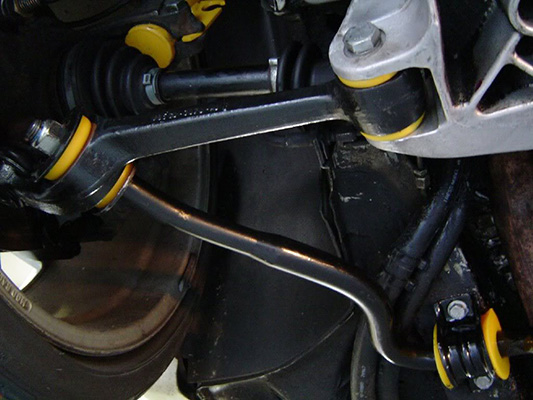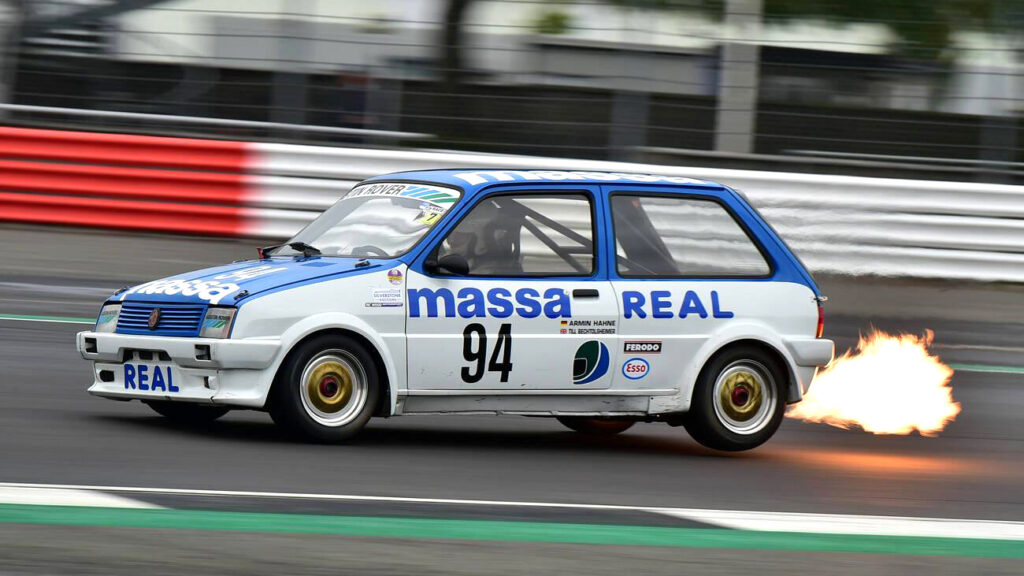Sway bars, also known as stabilizer bars or anti-roll bars, are a very popular first upgrade. In contrast to other mods like coilovers, they provide a significant improvement in handling for not a lot of money.
As the name suggests, anti-roll bars are designed to limit body roll. They also allow you to change your car’s handling profile by altering its tendency to understeer or oversteer.
They prevent roll-overs to some extent, however this isn’t a common concern with lowered tuner cars or race cars in general. It’s more of a concern with overlanding rigs.
Read on to learn more about sway bars and why you should totally install them in your car.
What Are Sway Bars and What They Do

A sway bar is a U-shaped cylinderical bar that couples two opposing sides of the suspension. In other words, it connects opposite (left and right) wheels together, with the purpose of altering roll stiffness.
This connection is made by short lever arms (end-links) that are bolted to the lower suspension members. The two opposing end-links are connected by the actual sway bar.
Lower Body Roll and Equal Load Transfer
The sway bar is basically a torison spring, which means it resists twisting motion — the ends always want to remain parallel to each other.
It is intended to force the opposing wheels of the car to lower or rise in equal proportion when driving over road irregularities or when cornering at high speed.
Confused? Consider 2 driving scenarios:
- You approach a speed bump at a perpendicular angle, and drive over it. In this case, both sides of the suspension will move up and down together, in an equal amount.
- You either go hard into a corner, or you hit a bump with only one side. In both cases, one wheel encounters more vertical force than the other.
In scenario 1, the sway bar will do nothing at all, it will simply move up and down along with the two wheels. But in scenario 2, it’s going to undergo a twisting force as it tries to level the wheels out. Remember, sway bars want to stay parallel on both ends.
Each end of the sway bar is connected to an end-link, which is connected to the lower suspension arms. This effectively links both sides of the suspension.

As one side compresses, the sway bar twists and tries to compress the opposite side as well. Here’s how that plays out in scenario 2.
During cornering, when there’s a lot of lateral acceleration, the weight of the chassis shifts towards the outside of the turn, which compresses the spring on that side. Meanwhile, the spring on the inside wheel extends a bit.

As the suspension on the outer wheel compresses, the sway bar twists in the direction of that force and transmits some of it to the opposing wheel. With that, the inner wheel compresses as well.
As a result, load and traction on the inner and outer wheels is equalized to some extent. This improves lateral grip, making your car safer, faster, and more predictable when going around a corner.
It also improves acceleration and braking; and it minimizes unwanted changes in camber angle and suspension geometry.
Why You Want Equal Load Distribution

Tires are load sensitive. As the load on your tires increases, their coefficient of friction decreases. For example, consider two opposing tires that have a combined grip of μ0.7 at equal load.
If the body roll is too high during a corner and there’s too much load transfer between the two tires, their combined grip will drop below μ0.7, and it’ll continue dropping as the load increases.
The higher the imbalance in load distribution, the lesser their combined grip. In other words, you’ll lose more grip on the inside tire than you’ll gain on the outside tire when cornering.
Sway bars help with this issue by equalizing load transfer and making both tires do the work instead of just one. However, there’s a catch. If your sway bar is way too stiff, it’s going to make the imbalance in load distribution even worse.
The stiffer the sway bar, the more weight it transfers across the axle, and the less combined grip the pair of tires will make.
This applies not only to load transfer between left and right axles, but also for front and rear axles. For instance, if you soften the front sway bar too much, you’re robbing grip from the rear, and vice versa.
Which is why it’s so important not to push too extreme with your sway bar stiffness. If you do, you’ll reach a point where one of your tires will have near-zero load.

This is especially common with some front-heavy cars; they’re prone to 3-wheeling through corners. When that happens, the wheel with the least amount of grip can lock-up just as easily as it can spin out.
Altering Understeer and Oversteer Balance
Sway bar tuning is all about finding the right balance. The roll frequency between the front and rear wheels should be matched correctly in order to avoid undesirable driving characteristics such as too much turn-in understeer or snap oversteer.
As mentioned earlier, changing the stiffness of the sway bar allows you to alter the grip of the wheels that it’s connected to. This change in grip affects all 4 tires.
For example, if you add an overly stiff sway bar at the rear, you will lose grip at the rear, but you will gain some at the front.
Of course, this depends on factors such as your car’s damper settings, static weight distribution (front vs. rear-heavy), drivetrain layout (RWD, FWD, or AWD), and its natural tendency to understeer or oversteer, to name a few.
Most production cars are designed to understeer a bit. To change that, or to dial in your car’s balance with sway bars, here’s what you need to know.
| Steering Balance | Front | Rear |
|---|---|---|
| Understeer | Soft | Stiff |
| Oversteer | Stiff | Soft |
- To reduce understeer: Install a rear sway bar or remove the front sway bar
- To reduce oversteer: Install a front sway bar or remove the rear sway bar
If your car already has a sway bar, follow the same logic; you can install stiffer or softer sway bars as needed.
For clarity, understeer occurs when you turn the wheel and the car wants to keep going straight. The grip on the front is a lot less than what you have on the rear. In this case, the front tires start slipping much before rear tires.

Oversteer occurs when the car steers more than you intend it to. It happens when there’s a lot more grip on the front tires and a lot less on the rear; the rear end will want to kick out. You want a neutral balance to use all 4 wheels at their maximum potential.

It’s worth noting that sway bar tuning is secondary. Ideally, any balancing issues should be fixed before you install the sway bar. Primary modifications include:
- Changing your camber, caster, and toe alignment settings.
- Installing negative offset rims and wider tires to increase your wheel track width.
- Lowering your car’s center of gravity.
- Installing a roll center correction kit.
- Dialing in your suspension setup.
Sway bars typically have multiple mounting points which allow you alter the leverage of the bar by making it longer or shorter. Shortening the bar makes the torison spring stiffer so it reacts more quickly.

You’re All Set
Of all the handling upgrades you can spend money on, sway bars are by far the most effective. Just be sure not to go too stiff on either the front or the rear, and you’ll be good to go.
Now that you know the basics of how they work and what to expect from them, it’s time for you to get your own sway bars on order. Check out our wide range of products today.




